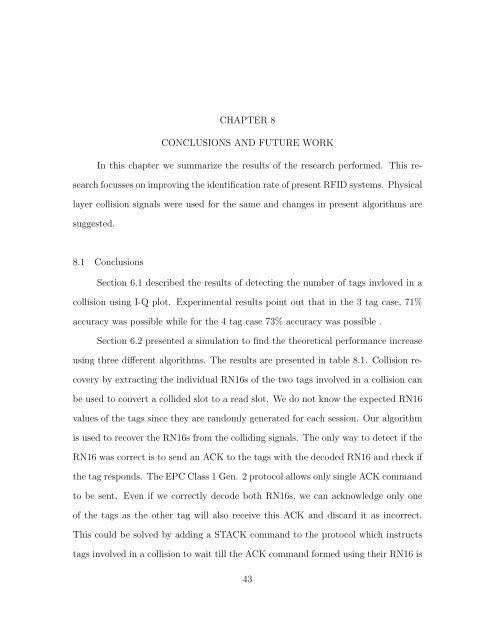utilizing physical layer information to improve rfid tag
utilizing physical layer information to improve rfid tag
utilizing physical layer information to improve rfid tag
You also want an ePaper? Increase the reach of your titles
YUMPU automatically turns print PDFs into web optimized ePapers that Google loves.
CHAPTER 8<br />
CONCLUSIONS AND FUTURE WORK<br />
In this chapter we summarize the results of the research performed. This re-<br />
search focusses on improving the identification rate of present RFID systems. Physical<br />
<strong>layer</strong> collision signals were used for the same and changes in present algorithms are<br />
suggested.<br />
8.1 Conclusions<br />
Section 6.1 described the results of detecting the number of <strong>tag</strong>s invloved in a<br />
collision using I-Q plot. Experimental results point out that in the 3 <strong>tag</strong> case, 71%<br />
accuracy was possible while for the 4 <strong>tag</strong> case 73% accuracy was possible .<br />
Section 6.2 presented a simulation <strong>to</strong> find the theoretical performance increase<br />
using three different algorithms. The results are presented in table 8.1. Collision re-<br />
covery by extracting the individual RN16s of the two <strong>tag</strong>s involved in a collision can<br />
be used <strong>to</strong> convert a collided slot <strong>to</strong> a read slot. We do not know the expected RN16<br />
values of the <strong>tag</strong>s since they are randomly generated for each session. Our algorithm<br />
is used <strong>to</strong> recover the RN16s from the colliding signals. The only way <strong>to</strong> detect if the<br />
RN16 was correct is <strong>to</strong> send an ACK <strong>to</strong> the <strong>tag</strong>s with the decoded RN16 and check if<br />
the <strong>tag</strong> responds. The EPC Class 1 Gen. 2 pro<strong>to</strong>col allows only single ACK command<br />
<strong>to</strong> be sent. Even if we correctly decode both RN16s, we can acknowledge only one<br />
of the <strong>tag</strong>s as the other <strong>tag</strong> will also receive this ACK and discard it as incorrect.<br />
This could be solved by adding a STACK command <strong>to</strong> the pro<strong>to</strong>col which instructs<br />
<strong>tag</strong>s involved in a collision <strong>to</strong> wait till the ACK command formed using their RN16 is<br />
43
















